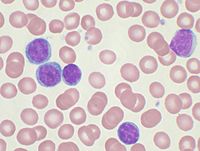
Photo from wikipedia
A 58-year-old man with a history of short telomere syndrome developed interstitial pulmonary fibrosis and underwent bilateral lung transplantation 20 months prior to presenting with fever and night sweats. He… Click to show full abstract
A 58-year-old man with a history of short telomere syndrome developed interstitial pulmonary fibrosis and underwent bilateral lung transplantation 20 months prior to presenting with fever and night sweats. He was found to have a macrocytic anaemia, thrombocytopenia and circulating blasts (9%). The bone marrow aspirate was hypercellular with increased blast cells (37%) in a background of trilineage dysplasia. The blasts were large and pleomorphic, with highly atypical morphology, including cells with large, pleomorphic nuclei, prominent nucleoli and abundant vacuolated cytoplasm, as well as binucleate forms (left). The blasts were positive for myeloperoxidase (small subset) and negative for nonspecific esterase by cytochemical staining and, by flow cytometry, positive for CD45 (weak), CD34, HLA-DR, myeloid markers CD13, CD33, CD117, CD15 (subset), CD64 (small subset), CD11b (small subset), CD123 and the T-cell marker CD7, but negative for CD56 and other myeloid, monocytic, B-cell and T-cell markers. The bone marrow core biopsy sections showed extensive (60–70%) marrow involvement by CD34-positive blasts with background trilineage dysplasia (right). Cytogenetic analysis showed: 47,XY,-4,add(5)(q11 2),-7,del(8) (p11 2),i(9)(p10),+11,add(12)(p11 2),+21,+22[cp20].nuc ish (D5S723/D5S721x2,EGR1x1)[98/100],(D7Z1,D7S486)x1[91/ 100]. Next generation sequencing-based molecular studies showed loss of genes on 4q, 7p, 7q and 12p, and a pathogenic TP53 D281V point mutation with an allele frequency of 90 5%, increased from 4 1% at a prior analysis. A diagnosis of acute myeloid leukaemia (AML) with myelodysplasia-related changes (AML-MRC) was made. Because of the dismal prognosis, the patient elected to receive palliative care and expired two weeks later. Short telomere syndromes, including dyskeratosis congenita, are genetic disorders caused by mutations in genes encoding components of the telomerase holoenzyme, including TERC, TERT and DKC1. They have diverse clinical manifestations, including idiopathic pulmonary fibrosis, which typically occurs in adults in the fifth decade of life. Affected individuals are at increased risk of developing bone marrow failure and liver disease, as well as haematological malignancies, such as myelodysplastic syndrome (MDS) and AML, which may be due to telomere defects leading to genomic instability, immunodeficiency and failure of cancer immunosurveillance, and/or a state of organ failure, such as aplastic anaemia. In this case, the patient developed de novo AML-MRC, including MDS-related cytogenetic abnormalities and highly atypical myeloblasts.
Journal Title: British Journal of Haematology
Year Published: 2018
Link to full text (if available)
Share on Social Media: Sign Up to like & get
recommendations!